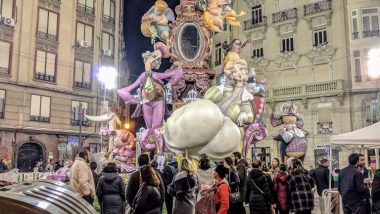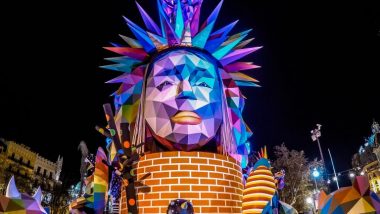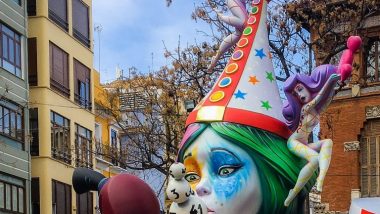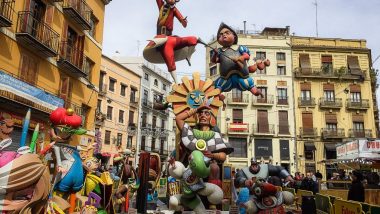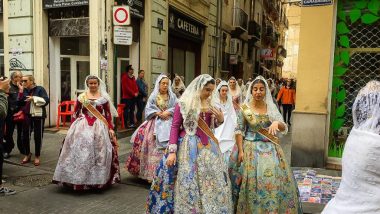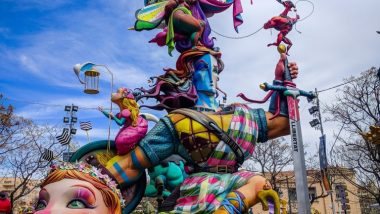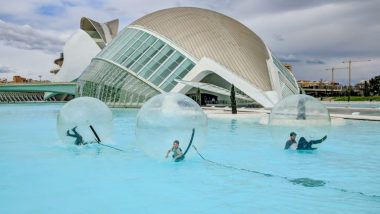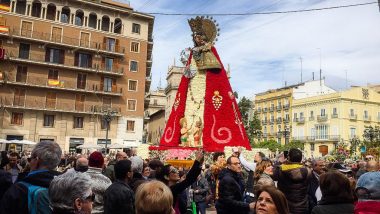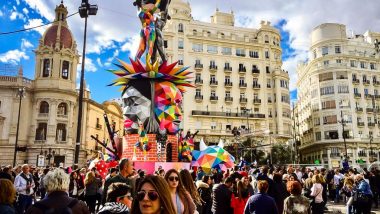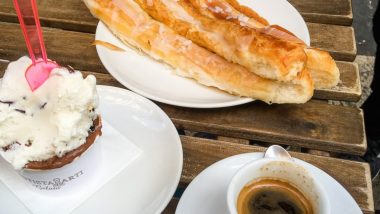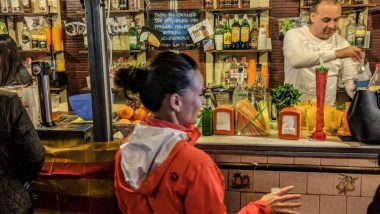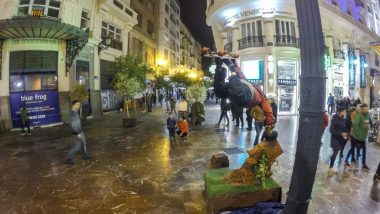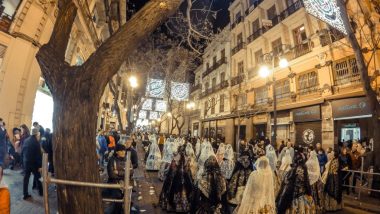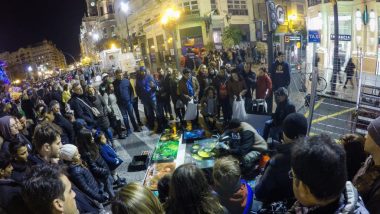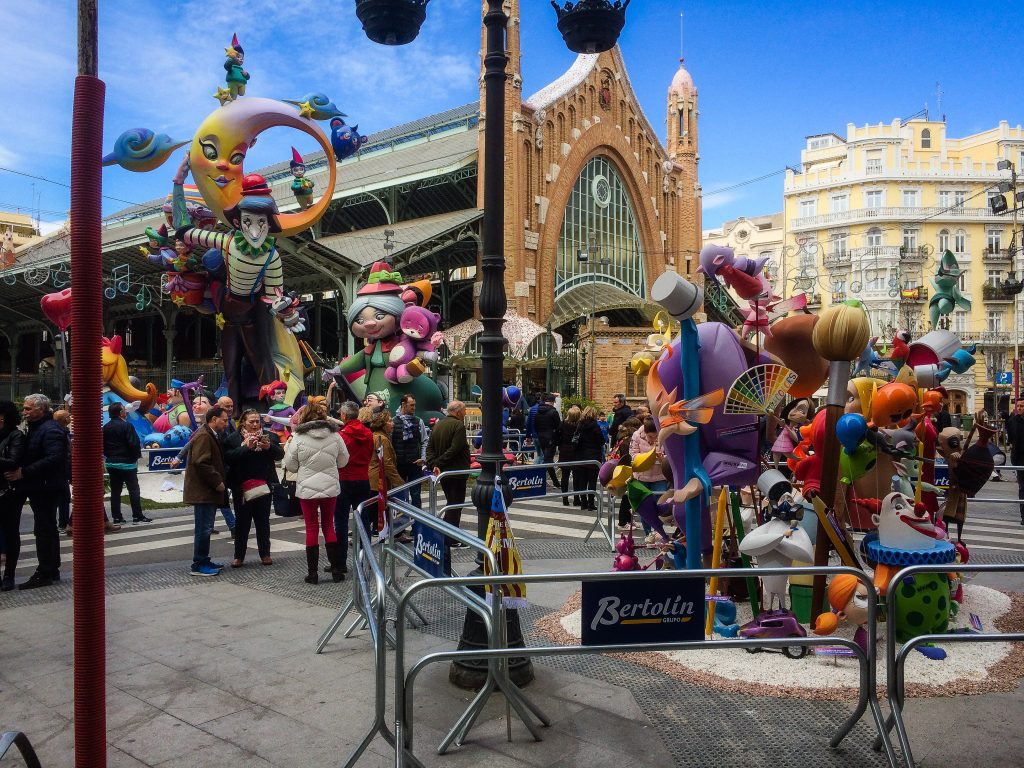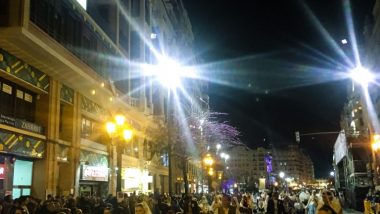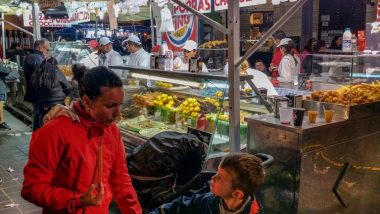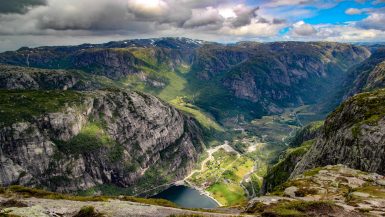Festival detour
As we were spending the spring south of Torrevieja in Spain, we just had to go to Valencia in mid-March.
It was time for the region’s biggest festival of the year, the famous Las Fallas.
Every March the city literally explodes.
Not only because of the hundreds of thousands of visitors that pilgrim here to partake in this spectacular event. The town itself get shaken to its foundation by ear-deafening explosions caused by thousands of fireworks in different form and shape that are discharged all across town.
Las Fallas is held each year on the same dates, between March 1st -19th , with the main event taking place on March 15th -19th.
San José
Las Fallas means “the fires” in Valencian and is a celebration in memory of San José (Saint Joseph). He is the carpenters’ patron saint and is celebrated on the 19th of March, which is also the last day of the festival.
The (shortened) reason the Las Fallas is what it is originates several centuries back. In a time when artisans and carpenters burnt simple wooden structures as a celebration of the end of winter and the start of brighter, warmer days.
This became a tradition that evolved more and more over the years until it eventually ended up being Las Fallas as we know it today.
Crazy expensive hotels
During the main days of the festival the city hotels quickly get fully booked and the prices skyrocket.
A slight lack of foresight ment that we made reservations only a month ahead, which lead to serious problems finding a decent room.
We ended up booking a room in a unmanned hotel. No breakfast, no nothing, just a decent sized, clean and very basic room in the middle of the city center. At the insignificant cost of 200 EUR/night.
The hotel was located in a narrow alley just next to a crowded restaurant.
We only had an entry code from the owner so we could get into the stairwell. Inside there was a safety box with another code from where we retrieved the key to our room.
Minimum effort for the owner and convenient for us as the arrival instructions were straightforward. Even though, for the price we paid, he should have been standing at attention outside the hotel with the key in one hand and a glas of champagne in the other.
No traffic allowed
The city center will be shut down to traffic during this time so take that into consideration if you are planning to visit.
We arrived in Valencia late at night. Of course the traffic limitations should not have come as a surprise for us, but it did. And finding a parking lot this time in the evening was not an easy task. (I was completely stressed out – as always…)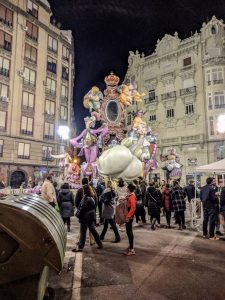
Finally we found a 24-hour garage connected to one of the largest shopping malls in the city center outskirts. We dumped the car there and walked three kilometers back to the hotel.
It could have been a boring walk. But it was actually quite the opposite.
Loads of people walked the same way as us. Many of them dressed in traditional Valencian costumes, both adults and young children, even if it was late in the night.
All the tiredness went away and anticipation set in. Soon the streets were packed with people, and suddenly we saw our first “ninot”. One of the more than 800 cartoon-like statues that are placed all around town during the festival.
The evening starts late in Spain
We just love the “Spanish time zone”. When people are going to bed in Sweden (around 9-10 pm) the Spaniards are just on their way out having dinner.
The reason for Spaniards having such nocturnal habits dates in fact all the way back to the 1940´s, when general Franco decided to change Spain´s time zone to show solidarity with Nazi Germany.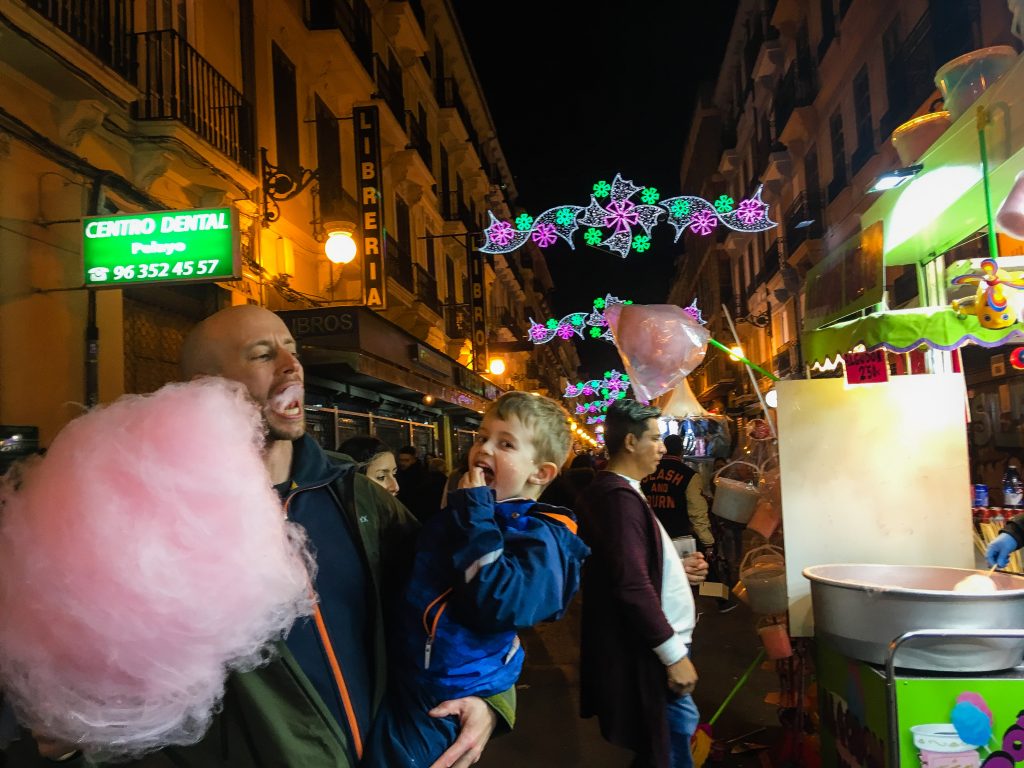
This change got stuck and is the reason why Spaniards need their mid-day siestas and keep having irregular, late working hours.
“During my summer in Barcelona I first could not figure out why all restaurants in my neighborhood were closed when I wanted to grab something to eat at 8 pm.
It took me a week or so to adjust my life to the local traditions. Nowadays I think it is great. We have always been kind of an night owls, and the Spanish relaxed lifestyle that encourages late night family dinners really appeal to us. I doubt that we will spend all winters in dark Sweden in the future…”
Ninots everywhere
During Las Fallas the ninots can be seen in more than 350 places all over town.
The ninots are made of wood and papier mâché. Some of them are really huge, reaching heights of up to 10-15 meters (33-49 ft).
The themes are mixed and usually they have some sort of satirical message connected to the past years events.
There are professional ninot makers working all year round building the sculptures and their handicraft is nothing less than brilliant. Some of the ninots look like they have been taken straight from an animated movie.
Then they all burn
So what happens to all ninots when the festival is over?
One might think that such delicate handicraft are sold to the highest bidder or at least that they are being taken care of properly.
Well, no. On the last day of Las Fallas all ninots, all but one, are filled with fireworks and set on fire.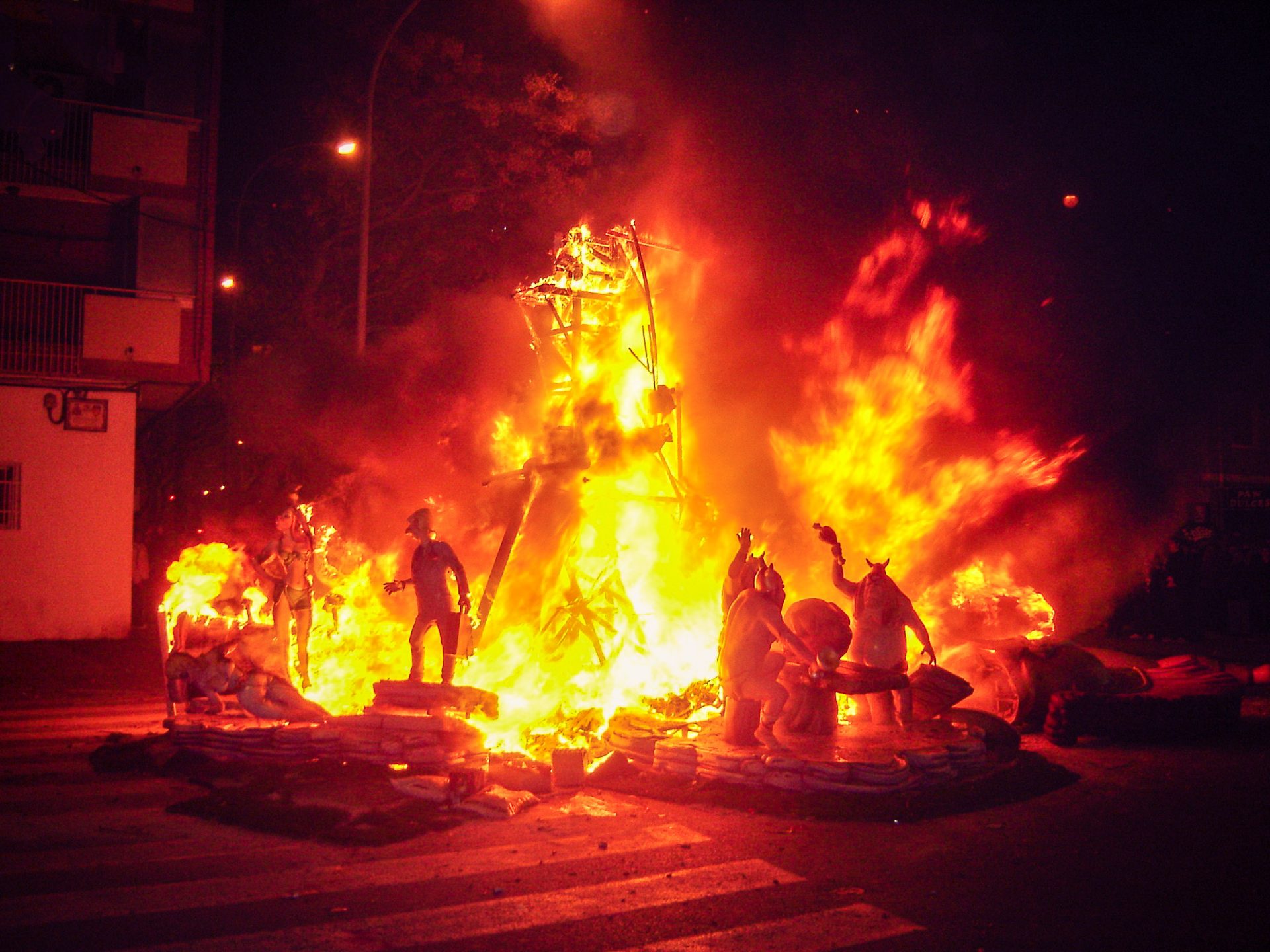
This last night is called “La Cremá”.
The first fallas to be burnt are the “Fallas Infantiles”, the sculptures that are made for the children.
Later in the evening it is time for the regular ones to be engulfed in flames, reducing all that beauty into a pile of ashes.
The only ninot that is spared from the flames each year is called “el Ninot Indultat” (the pardoned ninot).
People vote for their favorite ninot during a pre-Las Fallas indoor exhibition and the winner gets to be displayed in the local Museo Fallero (Fallas Museum), where it can be seen together with winners from previous years.
Nit del Foc
Spanish people love fiestas and they love fireworks.
Never in my life have I experienced such pyrotechnical mayhem as I have in Spain. We have witnessed it in Barcelona during the Gràcia Festival and in Pamplona during la Fiesta de San Fermín.
When I saw the cascade of fireworks in Pamplona I thought that I would probably never experience something similar again. Until we went to Valencia.
On the last night, the night between the 18th-19th of March, the biggest “Castillo” (firework show) of the year is held. This night is called “Nit del Foc”, translated into “the Night of Fire”.
The sky literally turns into flames when more than 4,000 kilos of fireworks are shot into the sky.
If you are into fireworks in any way, you have got to go and see this!
La Mascletà
Not a day goes by during Las Fallas when there is no pyrotechnics. It is just that, that some moments are crazier than others.
Every day at 2 pm, the big bang fetishists go all in at the Plaza del Ayuntamiento, the main square, as it is time for the Mascletà!
If the firework show of the Nit del Foc is about showing of the most mesmerizing visual effects, the Mascletà is more about giving the spectators a smack in the face as the loud explosions makes Valencia shake.
The detonations increases the closer to the end it gets, and during the final climax the noise is absolutely deafening.
Make sure to bring earplugs, especially if you have kids. There have been quite a few incidents where people have gotten reduced hearing because of it.
The Mascletà is all about feeling it, not seeing it, so you do not have to be that close.
Only in Spain or never in Sweden
Never ever would such a magnitude of explosions and loud sounds be tolerated back in Sweden, the Mascletà is like a war zone.
In Valencia, people of all ages are walking around with (pretty big) firecrackers that they throw on the streets were people are walking. BUT, and this is the thing – In Spain they can behave, in Sweden they cannot.
“Lagom”
I guess it has to do with the fact that Swedes in general always are “lagom”, a word that do not have an appropriate English translation. The best description is probably “moderate” or “just enough”.
Swedes like “lagom”, and that makes them somewhat boring and reserved. Unless they drink a bit of alcohol that is.
And of course, as Sweden is a “lagom” country, it has lots of strict regulations regarding the buying and drinking of alcohol. And that could be a good thing – if we were not so bloody “lagom”.
Because when Swedes drink, they have a bad habit of drinking too much. And then they cannot behave. No, we are not as bad as the English or Russian, but not too far away.
In Valencia we saw a lot of younger people, sitting together in the parks in the midst of all the festivities, drinking and having fun.
Nothing extraordinary with that, some even looked a bit drunk. But not once, not ONCE, did we hear or see anyone jelling profanities or being aggressive, even late at night.
That would most likely never have been the case in Sweden.
In Valencia, with thousands and thousands of people squeezed together, with young and old, firecrackers and loud music, all mixed into one big fiesta – we did not witness one single brawl or other incident, during the whole weekend.
Unreal… (In a very, very positive way.)
Drinks and sweets and an offering or two
In the middle of this constant haze and smell of gunpowder hanging over the town there are a lot of other events that one can immerse oneself in.
Witness the “La Ofrenda”, the floral offering.
It is a magnificent procession where thousands of falleras (f) and falleros (m) dressed up in beautifully decorated, traditional, regional costumes parade down the streets towards the Plaza de la Virgen.
At the plaza they gather around the gigantic statue of the “Virgen de los Desamparados” (Our Lady of the Forsaken). She is the patron saint of Valencia.
The Ofrenda lasts for two days, March 17th -18th, during which time the statue and the rest of the plaza is filled with a mountain of flowers brought there by the steady stream of arriving fallas groups.
La Despertá
Each fallas procession is accompanied by their own marching/brass band.
At 8 a.m. every morning during Las Fallas these bands starts playing, waking up the city. This is called “la Despertá” or “the wake-up call” and works as a reminder to people that the festival is far from being over and that it is time to get up.
There are more than 350 fallas (communities) in Valencia, and each one has selected their own “Fallera Mayor”, or “Queen of the Falla”.
But of all the falleras and falleras mayores participating each year there will be only two, one adult and one child, that gets to be “Falleras Mayores de Valencia”.
They are the queens of the whole festival and it is the greatest of honors to become the chosen one.
Feeling hungry?
Well, you have come to the right place then. Everywhere you will find street food vendors serving different local delicacies and sweets.
Why not start out with a big portion of paella Valenciana served from a huge saucepan.
Then go to the churrería next door and order a plate of warm churros or buñuelos, served with a big cup of chocolate sauce. You will find yourself being in desert heaven.
Churros are best described as deep-fried doughnut sticks, while a buñuelo, also deep-fried, is rounded in shape and made of pumpkin. Equally delicious nevertheless.
A Cuban drink stall served one of the most decent tasting mojitos we had ever had.
The City of Arts and Sciences
Before we headed back south again we spent one morning around the Museu de les Ciències Príncep Felipe, or the Valencia Science Museum. It is part of the Ciutat de les Arts i les Ciències, “The City of Arts and Sciences” complex.
In addition to the science museum there is also a planetarium, an oceanarium, an IMAX theatre, a musical palace and a botanical garden here.
As you might already have understood, the whole area is huge. It covers about 350,000 sqm, and it is situated within easy walking distance from the city center.
Fun for both kids and grown ups
The museum and the other buildings in the complex all have a very futuristic appearance. Their modern architecture looks a bit like a movie scene were a alien spaceship has landed on its side in a lake.
If you ever plan on visiting Valencia this place is a must!
If you are travelling with kids, it is a even bigger must. There are tons of activities here, for kids of all ages.
By using interactive installations they have created an environment where kids can learn science and technology in a fun way. Leo kept himself busy by trying out different kinds of machines and gadgets.
He finally got himself that Rubik’s cube that he had wanted for so long, and even had time to try out one of the centers cool water activities.


